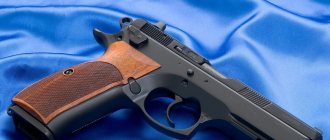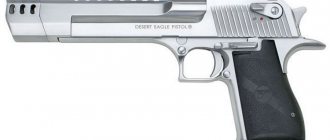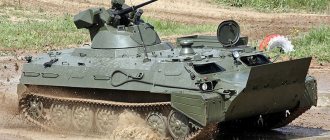Weapon of Victory
The experience of the First World War and the Civil War convincingly showed that the very existence of the Soviet state is impossible without taking urgent measures to equip the Red Army with the latest military equipment. Among the various types of this equipment, automatic weapons were given one of the first places.
Even during the difficult years of the Civil War and the subsequent devastation of the economy and production, funds were found and work began to design new automatic weapon systems and create an appropriate base for their development and production.
7.62 mm submachine gun mod. 1940 (PPD-40). In the archival photo, the PPD submachine gun has a sector sight, in the top photo there is a simplified two-position rear sight made during wartime
For this purpose, in Kovrov, on the basis of the “Special Workshop”, the first design and construction bureau in our country was created, which for a long time was headed by the wonderful Soviet gunsmith V. A. Degtyarev, and in organizing and establishing the work - the creator of the world’s first machine gun, V. G. Fedorov. Based on the work of the PKB, the level of constructive development of new weapons significantly increased and a cadre of designers were trained, in many ways surpassing their teachers (G. S. Shpagin, S. G. Simonov, P. M. Goryunov, etc.)
7.62 mm Maxim machine gun mod. 1910/30 modernized during the war (1941-1944)
The Tula design school was also traditionally strong, represented by S. A. Korovin, F. V. Tokarev, N. V. Rukavishnikov, S. V. Vladimirov and others. The shooting and tactical courses “Vystrel” played an important role in the shooting training of troops. the head of which was appointed the outstanding theorist and practitioner of small arms N. M. Filatov, who created major works on the foundations of rifle and machine gun shooting. Of great importance in the training of designers and scientists was the creation during the pre-war five-year plans of special departments of small arms and machine guns at the Artillery and Air Force Academies, the Tula and Leningrad Mechanical Institutes. Thanks to the scientific works of A. A. Blagonravov, E. L. Bravin, V. S. Pugachev, M. A. Mamontov, the design of weapons was put on a scientific basis.
As a result of the consolidation of intellectual potential, combat experience and the implementation of the country's industrialization plan, the development of the Red Army's weapons occurred in two independent directions. The first (in terms of small arms) was practically completed in 1930. Then the rearmament of the Red Army with modernized models of infantry weapons (7.62 mm Nagan revolver, 7.62 mm rifle model 1891/30 and 7.62 mm a Maxim machine gun, and later a carbine model 1938), which differed from its predecessors in improved operational and technological characteristics, which played an important role for the country’s economy in the pre-war years.
7.62 mm Tokarev self-loading rifle (SVT-40) with a bladed bayonet
Further work in this direction was intensified only after the start of the Great Patriotic War. The second direction of development implied the creation of new weapons that have no analogues not only in domestic, but often in world weapons practice. At the same time, what is surprising is a truly scientific, systematic approach to solving the problem (which is so lacking these days) - it was the weapon system that was to be developed (consisting of a pistol, submachine gun, self-loading rifle, anti-tank rifle, light, heavy and heavy machine guns, rifle grenade launcher and a 50-mm company mortar), designed to function according to the general tactical requirements of the Infantry Combat Manual (in accordance with which the required accuracy and efficiency of fire, rate of fire, effective range, firing modes, maneuverability were determined) when operating as part of units in various types of combat, reinforced requirements for reliability and safety, maintenance and repair.
7.62 mm submachine gun mod. 1941 (PPSh-41) with a simplified two-position rear sight and a two-row sector magazine with a capacity of 35 rounds
The first result was obtained already in 1927 - the first domestic light machine gun DP (Degtyarev infantry) was adopted for service, designed to replace the extremely worn-out light machine guns of various foreign systems, inherited from the times of the First World War and intervention. The machine gun was warmly received by the troops and highly praised for its fire power and ease of design and maintenance. In 1928, its aviation modification in a turret version - the DA machine gun - entered service, and in 1929 a tank modification - DT. Moreover, no one had any illusions regarding the survivability of the tanks - the DT machine gun was equipped with a kit for use in the infantry version (bipod with a sight). Unfortunately, few people learn the lessons of history; modern tank machine guns do not have such a set and cannot be used for firing if the tank fails. But some armored vehicles have as many as three machine guns (BMD-1). And the point here is not in the technical complexity of the task (after the defeat of a tank column in Grozny, Shevchenko and Danilov developed and tested it), but in criminal thoughtlessness. But let's return to our story.
So, the “first pancake” turned out to be far from lumpy. The operation scheme of the automatic machine gun and the design of the bolt locking unit turned out to be so successful that they formed the basis for the development of both easel (DS-39), and large-caliber (DShK model 1938), and manual chambered for the cartridge model 1943 (RPD-44 ) machine guns. In the development of submachine guns, Vasily Alekseevich also achieved the best results - in 1934, the PPD-34 of his design was adopted, which underwent two successive modernizations in 1938 and 1940, but still the cost was close to the cost of a light machine gun.
7.62 mm Degtyarev heavy machine gun (DS-39)
The competition to create a self-loading pistol ended with the adoption of a 7.62 mm pistol mod. 1930 (short name of TT - “Tula Tokarev”). True, just three years later the pistol underwent modernization in order to simplify and reduce the cost, taking on the well-known appearance and name - pistol mod. 1933
7.62 mm pistol mod. 1933 (TT)
Taking Browning's automatic operation scheme as a basis, F.V. Tokarev created his own original design, the viability of which has been tested by time and experience in combat use in dozens of wars and local conflicts. Things were somewhat more complicated with the development of a self-loading rifle. At first, S.G. Simonov was in the lead in the competition, and the political desire to have the most progressive main infantry weapon overshadowed common sense and the still “raw” system was put into service in 1936 under the abbreviated name ABC-36.
Experience in the production and operation of the ABC-36 revealed shortcomings, the elimination of which would require a radical redesign of the rifle in terms of ensuring strength and reliability and would inevitably increase the weight. Under these conditions, Tokarev took the lead with his SVT-38, which was also not without its shortcomings, but not of a constructive nature, but rather of a technological nature (it turned out to be expensive in mass production), which led to its modernization in 1940. Along the way, the weight was reduced and increased reliability of automation.
7.62 mm revolver mod. 1895
So, the USSR became the first state in the world to have a mass-produced self-loading rifle in its infantry arsenal. The achievement in this area was convincingly demonstrated to the whole world by equipping honor guard companies with self-loading weapons. The SVT served as a “ceremonial” weapon until it was replaced by the Simonov SKS. The development of anti-tank rifles, which began vigorously in the late 20s and early 30s, gradually faded away, ending with the creation of a number of prototypes and the accumulation of experience in their development. However, even in the German army they were quite skeptical about the effectiveness of the combat use of this type of weapon. New and modernized models gained experience in combat use in the harsh conditions of local conflicts on Lake Khasan and the Khalkhin Gol River and in the Soviet-Finnish War of 1939-40, where an invaluable store of knowledge was obtained about the actual use of weapons in the army (often by poorly trained personal composition) implemented in test procedures. After all, the obvious haste in adopting some models is explained not only by external threats, but also by the lack of testing experience (almost everything was done for the first time) and evaluation of the results, and the weakness of the methodological and material and technical base of testing.
Underestimating the combat effectiveness of submachine guns cost our troops dearly in the war with Finland, and it was not possible to significantly increase their production in the shortest possible time due to the high labor intensity and cost. It was possible to fill this gap in record time - nine months after the end of the Finnish company (taking into account the time of the announcement of the competition, development and testing) in December 1940. A sample of the design of Georgy Semenovich Shpagin under the name 7.62-mm submachine gun was adopted for service. arr. 1941 (abbreviated PPSh). “Daddy,” as the soldiers affectionately called him, while maintaining all the positive qualities of the PPD, was distinguished by enviable manufacturability due to the use of cold stamping in the production of the main parts. It was the timely appearance of this, the most popular submachine gun of the Second World War, that became the key and one of the symbols of the future Victory.
7.62 mm Goryunov heavy machine gun (SG-43)
So, by June 22, 1941, the Red Army had one of the most advanced small arms systems in the world. Obviously, the army did not receive all types of weapons in sufficient quantities, but the failures of the first period of the Great Patriotic War are not associated with poor equipment of the troops, but with miscalculations of the country's leadership and army command, because both Germany and its allies used obsolete weapons in significant quantities during the First World War, and a huge number of the latest Soviet models, taken as trophies, were immediately put into service. SVT rifles, PPD and PPSh submachine guns, DP and DShK machine guns were especially popular in the German ground forces. A captured SVT could be sold for 400 Reichsmarks, which was almost two months' salary for a company commander. With German pedantry, as well as with Finnish frugality and unspoiledness, even DS-39 machine guns worked flawlessly, but in our country, at the beginning of the war, DS production was curtailed. The dramatic fate of this machine gun has been little studied to this day and requires a separate narrative.
7.62 mm rifle mod. 1891/30
The beginning of the Great Patriotic War convincingly showed that the development trends of small arms developed in the 20s provided for even the most incredible development of events when repelling external threats (the official doctrine demanded “with little blood and on foreign territory”). No one could even imagine that within a month or two after the enemy’s invasion, the main industrial areas of the country would find themselves in occupied territory, and the army would lose the lion’s share of the most modern weapons concentrated in the border districts. This is where the results of the weapons modernization work carried out in the pre-war period (and which received additional acceleration after its start) were assessed, which significantly reduced the material intensity and labor intensity of manufacturing products, which ultimately made it possible to meet the needs of the army.
Already in the first border battles with the massive use of tanks, the half-forgotten issue of developing an anti-tank rifle arose. Pre-war developments in this direction (including the development of the 14.5 mm cartridge) allowed Degtyarev and Simonov to create domestic anti-tank rifles PTRD (single-shot with automatic unlocking and opening of the bolt) and PTRS (self-loading) in the shortest possible time, almost in a month. The first experience of combat use of PTRD took place on November 16, 1941 at the height of the Battle of Moscow. Already in the first clashes they showed high combat effectiveness, and from that time on they became an indispensable component of anti-tank defense, to strengthen which entire companies of armor-piercing soldiers were formed. Even after the appearance of heavy enemy tanks in 1943, which PTRs could no longer effectively fight, this class of weapons did not become obsolete and was actively used until the end of the war to combat firing points, lightly armored and unarmored vehicles.
14.5-mm anti-tank rifles: on the left - Degtyarev (PTRD), on the right - Simonov (PTRS)
Despite the difficult economic situation of the country, work on improving and developing new models did not stop throughout the war. Already in the first offensive operations of the Red Army, the need was identified for a light and compact submachine gun to arm scouts, sappers, crews of combat vehicles and artillery crews. Alexey Ivanovich Sudaev coped with this difficult task superbly. His PPS-42 successfully passed military tests in the harsh conditions of the wooded and swampy terrain of the Leningrad Front and, with some modifications, was put into mass production under the name “7.62-mm submachine gun mod. 1943" (abbreviated as PPS-43). The combat qualities of the PPS amazed even modern gunsmiths. In 2000, when testing their samples of submachine guns developed during the Baksanets R&D process, one of them, seeing the result of the PPS firing, barely whispered: “Everything has already been done before us...”. In general, the “turning point” year of 1943 became the starting point for the birth of “offensive” weapons, lighter and more maneuverable, better suited to the requirements of offensive combat.
7.62 mm submachine gun mod. 1943 (PPS-43) with a two-row sector magazine with a capacity of 30 rounds
In addition to the PPS, P. M. Goryunov’s heavy machine gun (SG-43) is being adopted and a 7.62-mm carbine is undergoing military testing (the following year it was named Model 1944 and replaced the Model 1891/30 rifle in production .). In 1944, Degtyarev, after analyzing the shortcomings identified during combat operation, modernized the DP light machine gun, which received the name DPM.
In addition, even at the very height of the war, the foundations of the post-war weapons system were laid - Elizarov and Semin worked on an “intermediate” cartridge, called the 7.62-mm cartridge mod. 1943, and venerable gunsmiths (Degtyarev, Simonov, Sudaev, etc.) began work on samples for it. In the same 1943, the still unknown Mikhail Timofeevich Kalashnikov began professional weapon design.
7.62-mm modernized Degtyarev light machine gun (DPM) Concluding a brief overview of the development of small arms in pre-war and wartime, it is necessary to especially note the invaluable contribution of domestic gunsmiths to the Victory over Nazi Germany. Almost all of the mentioned weapons, created by their tireless work, served for many years as a guarantor of security not only for our country, but also for the entire democratic community. When designing the material, images of samples stored in the Military Historical Museum of Artillery, Engineering and Signal Corps in St. Petersburg were used. Photo images - Mikhail Degtyarev
Main woman at the front
The front-line soldiers nicknamed the M-30 howitzer “Mother”, the rockets were initially called “Raisa Sergeevna” (from the abbreviation RS), but most of all they loved, of course, “Katyusha”, the BM-13 field rocket artillery system. One of the first volleys of Katyusha rockets hit the Market Square in the city of Rudnya. The BM-13 made a peculiar sound when firing, in which the soldiers heard Matvey Blanter’s song “Katyusha,” popular before the war. The apt nickname given to the gun by Sergeant Andrei Sapronov spread throughout the army in a couple of days, and then became the property of the Soviet people.
Monument to Katyusha. (wikipedia.org)
The order to start production of Katyushas was signed a few hours before the German invasion. The German troops were the first to use multiple launch rocket systems, trying to destroy the Brest Fortress at the very beginning of the offensive. However, the fortress survived and for a long time the Red Army soldiers who found themselves in it fought against the invaders. The order to start production of Katyushas was signed a few hours before the start of the German invasion. Less than a month later, Soviet troops struck back: in the summer of 1941, the Germans had to get acquainted not only with the new T-34 tank, but also with the hitherto unknown Katyusha. The Chief of the German General Staff, Halder, wrote in his diary: “On July 14, near Orsha, the Russians used weapons unknown until that time. A fiery barrage of shells burned the Orsha railway station and all the trains with personnel and military equipment of the arriving military units. The metal was melting, the earth was burning.”
Monument to the first rocket battery of Captain Flerov. (wikipedia.org)
Rocket launchers, which at the beginning of the war were most often mounted on the chassis of ZIS vehicles, then began to be mounted on anything: from Fords, Dodges and Bedfords received under the Lend-Lease program, to motorcycles, snowmobiles and boats. The operation in which multiple launch rocket systems were used most extensively was the assault on Berlin. Then the “Stalinist organs,” as the Germans called them, fired more than 10 thousand shells and destroyed 120 buildings, where the resistance of the enemy troops was especially fierce.
BM-13 "Katyusha"
When the first Katyusha approached the Orsha station captured by the enemy, the Germans did not even have time to figure out what was happening, as they immediately found themselves engulfed in fire from all sides. This super-effective weapon was secret and the soldiers were instructed to immediately destroy the anti-aircraft gun if there was a threat of capture by enemies.
To date, a little more than a couple of dozen BM-13s have survived in the world...
How much produced:30 000+
ZIS-3 gun
“Zosya”, also known as the “Stalin Salvo”, is the most massively produced artillery gun of the Second World War, and according to some sources, in the entire history of the world wars.
The biography of the ZIS-3 contains a lot of interesting details. For example, the first batch of 1000 guns was brought to the front secretly from Stalin, long before the “official approval”. You can read more about this in the book “Weapons of Victory,” authored by the creator of “Zosya,” Vasily Grabin.
How much produced: 48 000+
DP-27 machine gun
In third place in the popularity rating is the Degtyarev machine gun, released in 1927. Weight 9 kg without cartridges, firing rate 500 rounds per minute, range from 800 to 2500 meters.
How much produced: 795 000+.
T-34 tanks
"Thirty Four" is the most popular medium tank of the Second World War.
If in your city there is a tank in the central square, then with a high degree of probability this is it.
Oxford historian Norman Davis wrote about our tanks this way: “The maneuverable Soviet T-34s “hunted in packs” like wolves.” No other country had such an effective weapon against the clumsy German Tigers.
How many produced: 100,000+ (various modifications)
IL-2, "Cement Bomber"
The most popular combat aircraft in history, which for a long time was the Il-2 attack aircraft, seems to have become a record holder for the number of nicknames. “Concrete plane” - that’s what the German pilots called it: the Il-2 had poor maneuverability, but it was very difficult to shoot it down. The pilots even joked that the IL-2 could fly “on half a wing, and on my word of honor.” Wehrmacht ground troops, seeing it as a constant threat, called the plane the “butcher” or “Iron Gustav.” The designers themselves simply called the IL-2 a “flying tank.” And in the Red Army, the plane received the nickname “humpback” due to the unusual shape of the hull.
In this form, the Il-2 flew to the airfield. (wikipedia.org)
The first production aircraft "Il-2" was produced on March 10, 1941 at the Voronezh aircraft plant, since then 36,183 of the same attack aircraft have risen above the ground. However, at the time the war began, the Red Army had only 249 vehicles at its disposal. Initially, Ilyushin, the chief designer, created a two-seat “armored attack aircraft”, but after the first tests it was decided to install an additional gas tank instead of the second seat.
All the time, the Soviet command lacked specialized combat aircraft. This is largely why the IL-2, being the most common vehicle, was used for different tasks. For example, a mandatory bomb load was established for all Il-2 aircraft, which was jokingly called the “Stalin outfit”. In addition to bombing, the Il-2 was used, despite its impressive dimensions, as a reconnaissance aircraft. One of the interesting features of the attack aircraft is that the pilots, if the aircraft caught fire in combat, often landed the aircraft on its “belly” without releasing the landing gear. The most difficult thing for the pilot was to get out of the fuselage in time and escape before the IL-2 exploded.
GAZ-MM
The "lorry" was the most popular military vehicle of those years, the main means of delivering ammunition and transporting the wounded.
It is this car that Eduard Khil’s song “Frontline Truck” is dedicated to.
The GAZ-MM was distinguished by its light weight among other trucks and was the main transport for delivering goods across the ice of Lake Ladoga - the so-called “Road of Life”, the only route that connected Leningrad with the rest of the country during the siege.
How much produced:150 000+
PPSh machine gun
The most popular machine gun-pistol of the Second World War, which the soldiers affectionately called “daddy,” can be seen more often than other weapons on posters, medals, as part of monuments, in movies and computer games. Sometimes it is called the “symbol of victory.”
Its advantages were low cost of production, resistance to severe frosts, high speed (from 900 rounds per minute) and firing efficiency. The bullet easily pierced through a soldier in winter clothes from 200 meters. The weapon was also distinguished by its “endurance.” One machine gun was enough for 30 thousand shots.
How many produced: more than 5,000,000 (various modifications).
Yak-9 fighter
The most popular WWII fighter. It was developed under the leadership of aircraft designer Alexander Yakovlev. Only part of the aircraft's skin was made of metal (duralumin); in some places it was replaced by plywood or simply canvas.
How much produced: 16 000+
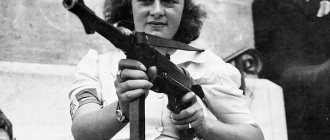
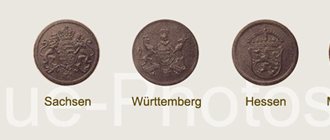
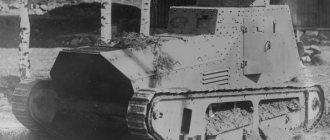
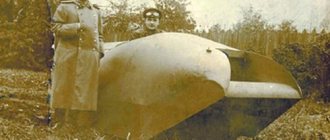
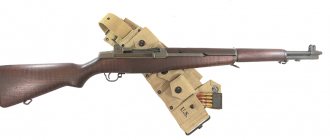
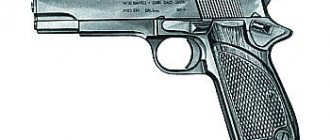
!['Domestic small arms [studio "Wings of Russia"] (2011)'](https://knifesburg.ru/wp-content/uploads/otechestvennoe-strelkovoe-oruzhie-studiya-krylya-rossii-2011-330x140.jpg)


